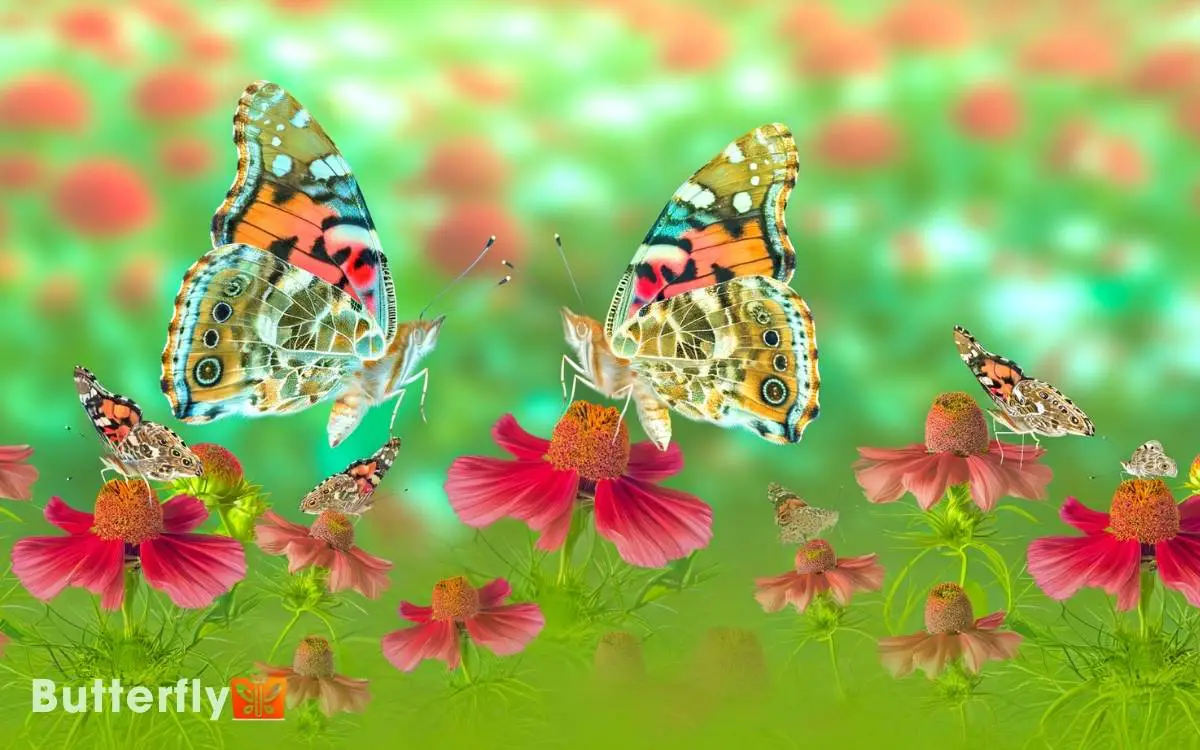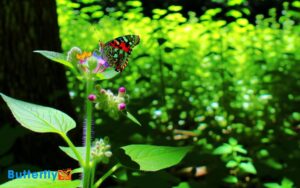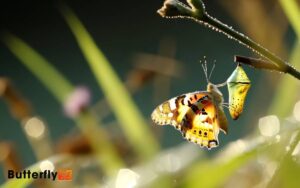How Do Painted Lady Butterflies Mate? Understanding Process!
Painted Lady butterflies engage in courtship through complex flight displays and precise pheromone communication.
Males perform rapid, looping flights in sunlit areas, using intricate patterns to attract females.
Females use visual cues like vibrant wing designs and intricate scents released at specific times.
The mating dance involves males spiraling and hovering to exhibit vigor, followed by chasing flights. Copulation occurs when males secure the female’s abdomen with claspers, transferring a spermatophore packet for fertilization.
Mating typically lasts 45 to 60 minutes. Females then seek ideal host plants for oviposition. Discover more about their fascinating reproductive strategies and lifecycle continuation.

Key Takeaways
Courtship Displays
During courtship displays, male Painted Lady butterflies exhibit intricate flight patterns to attract females. They perform a series of rapid, looping flights that demonstrate agility and vigor.
Observations reveal that these aerial maneuvers aren’t random but highly structured, often involving tight spirals and sudden directional changes.
The males position themselves prominently in sunlit areas, enhancing visibility. These displays serve to showcase the male’s physical fitness, a key factor in female selection.
Females watch these performances closely, evaluating the males’ stamina and coordination. The complexity of the flight patterns correlates with mating success, suggesting that females prefer males with superior flight capabilities.
Such precise behaviors indicate evolutionary adaptations aimed at optimizing mating opportunities.
Scent Communication
During mating, Painted Lady butterflies heavily depend on pheromone release timing to guarantee successful communication.
Males emit specific chemical signals that females recognize, triggering courtship behavior cues.
These intricate exchanges of scent play a vital role in coordinating mating activities.
Pheromone Release Timing
Female Painted Lady butterflies release pheromones at specific times to signal their readiness for mating, ensuring males are drawn to them at ideal moments.
This pheromone release typically coincides with periods when environmental conditions are best, such as during warmer parts of the day. Importantly, the timing of pheromone release can vary slightly depending on the butterfly’s age and physiological state.
This precise timing is essential for maximizing reproductive success and ensuring the continuation of the species.
| Factor | Observations |
|---|---|
| Environmental Conditions | Warmer parts of the day preferred |
| Butterfly’s Age | Variation in pheromone release |
| Physiological State | Influences release timing |
These factors collectively contribute to the strategic release of pheromones, optimizing mating opportunities for female Painted Lady butterflies.
Chemical Signal Recognition
Painted Lady butterflies utilize intricate chemical signal recognition systems to detect and respond to pheromones released by potential mates.
These signals, often volatile compounds, play a vital role in mating success. Their antennae contain specialized chemoreceptors that identify and differentiate these pheromones with remarkable precision.
The process involves:
- Pheromone Detection: Antennae sense pheromones in the environment.
- Signal Transduction: Chemoreceptors convert chemical signals into electrical impulses.
- Neural Processing: The brain interprets these impulses, distinguishing between compatible and incompatible mates.
- Behavioral Response: The butterfly moves towards or away from the pheromone source.
This chemical communication ensures that only the most genetically suitable mates are selected, enhancing reproductive success and species survival. These precise mechanisms highlight the sophistication of insect mating behaviors.
Courtship Behavior Cues
Male Painted Lady butterflies initiate courtship by releasing specific pheromones that trigger a sequence of behavioral responses in potential female mates.
These pheromones are detected by the females’ antennae, leading to a cascade of actions including wing vibrations and orientation towards the male.
This chemical communication is vital for successful mating as it guarantees species-specific recognition and compatibility. Observations reveal that the intensity and composition of these pheromones can vary, influencing female receptivity.
| Observations | Male Behavior | Female Reaction |
|---|---|---|
| Initial encounter | Pheromone release | Antennae detection |
| Proximity | Wing vibrations | Orientation towards male |
| Increased interest | Enhanced pheromone | Wing fluttering |
| Courtship display | Close following | Acceptance posture |
| Successful mating | Mating attempt | Copulation |
This pheromonal dialogue underscores the intricacy of Painted Lady butterfly courtship.
Visual Signals
Through intricate patterns and vibrant colors on their wings, painted lady butterflies utilize visual signals to communicate readiness for mating. These visual cues play an essential role in the courtship process.
Researchers have observed several key elements in these signals:
- Wing Patterns: The unique arrangement of spots and color bands helps in species recognition.
- Wing Movement: Flapping and positioning of wings can indicate health and vitality.
- Color Intensity: Brighter colors are often a sign of a well-nourished individual, attracting potential mates.
- UV Markings: Invisible to the human eye, ultraviolet patterns on the wings are discernible to other butterflies, enhancing communication.
These visual signals ensure that painted lady butterflies effectively convey their reproductive status, facilitating successful mating interactions.
Selecting a Mate
Building on the intricate visual signals, butterflies exhibit selective criteria when choosing a mate.
- Males assess females by examining wing coloration and patterns, seeking vibrant and symmetrical designs, which indicate genetic fitness.
- Females, in turn, evaluate males based on their vigor and flight patterns.
- A male’s ability to perform agile and sustained flights showcases his vitality and suitability.
- Females also discriminate based on pheromonal cues, guaranteeing compatibility and peak offspring viability.
Observations reveal that females often prefer males displaying territorial dominance, an indicator of superior genetic traits and resource-holding potential.
This selective process ensures that only the most fit individuals contribute to the next generation, promoting the species’ overall health and survival.
Mating Dance
Amidst the blooming meadows, Painted Lady butterflies engage in a complex mating dance that involves aerial displays and intricate maneuvers. This courtship ritual is vital for mate selection and successful reproduction.
During the dance, males and females exhibit a series of behaviors:
- Spiraling Flights: Males perform upward spirals to attract the attention of potential mates.
- Hovering Displays: Males hover near females, showcasing their vibrant wing patterns.
- Chasing Flights: Males chase females in swift, erratic paths to demonstrate vigor.
- Wing Vibrations: Males vibrate their wings rapidly to release pheromones, signaling readiness to mate.
These behaviors ensure that only the most fit individuals are selected, promoting the species’ overall health and survival.
Copulation Process
The copulation process in Painted Lady butterflies begins with intricate courtship and pair bonding behaviors that guarantee mutual receptivity.
Males transfer sperm to females using a specialized structure called the aedeagus, facilitating successful fertilization.
This mechanism guarantees genetic material is efficiently and accurately conveyed to the female’s reproductive tract.
Courtship and Pair Bonding
Courtship in Painted Lady butterflies involves a complex series of visual and chemical signals that facilitate mate selection. Males use their brightly colored wings to attract females while performing intricate aerial displays.
Female butterflies evaluate potential mates based on:
- Wing patterns: Vibrant and symmetrical patterns indicate good health.
- Flight displays: Complex maneuvers demonstrate physical fitness.
- Pheromones: Chemical signals released by males help females assess genetic compatibility.
- Territorial behavior: Males defend specific areas, indicating strength and suitability.
These behaviors guarantee that females select the most viable partners. Observations reveal that males often approach females from behind, ensuring the female’s receptiveness before initiating copulation.
This intricate courtship process minimizes energy expenditure and maximizes reproductive success, facilitating the continuation of the species.
Sperm Transfer Mechanism
Once the female Painted Lady butterfly signals her receptiveness, the male aligns his abdomen with hers to initiate copulation and facilitate the transfer of sperm.
During this process, the male uses his claspers to firmly grasp the female’s abdomen, guaranteeing a secure connection.
The male then inserts his aedeagus into the female’s bursa copulatrix, a specialized reproductive organ where sperm is stored.
Sperm transfer occurs through a spermatophore, a packet containing sperm and nutritional substances. The spermatophore not only fertilizes the female’s eggs but also provides her with essential nutrients.
This complex mechanism ensures successful reproduction by maximizing the chances of fertilization and enhancing the female’s overall reproductive success. The entire copulation process can last several minutes to hours.
Duration of Mating
During copulation, Painted Lady butterflies typically remain coupled for an average duration of 45 to 60 minutes. This period guarantees the successful transfer of sperm and essential nutrients that the male provides to the female. After mating, the female stores the sperm until she finds suitable host plants to lay her eggs, ensuring the best chances for offspring survival. In events such as a painted lady butterfly release, recently emerged butterflies may soon seek mates to begin the cycle anew. This natural process helps maintain healthy populations and supports pollination in various ecosystems.
Observations highlight several key behavioral aspects during this time:
- Initial Coupling: The male attaches to the female using specialized claspers.
- Nutrient Transfer: Alongside sperm, the male transfers nutrients to enhance the female’s reproductive success.
- Wing Positioning: Both butterflies maintain a stationary position with wings closed to minimize energy expenditure.
- Environmental Influence: Factors like temperature and humidity can impact the duration of mating.
These observations provide a thorough understanding of the mating duration, vital for the reproductive success of Painted Lady butterflies.
Post-Mating Behavior
After mating, Painted Lady butterflies exhibit distinct behaviors that are crucial for the female’s preparation for oviposition. The female’s primary focus turns to locating suitable host plants.
She demonstrates increased flight activity, spending considerable time inspecting potential sites. Males, on the other hand, engage in territorial behavior to maximize mating opportunities. They patrol their chosen areas, warding off rivals and seeking additional mates.
| Behavior | Female Actions | Male Actions |
|---|---|---|
| Site Inspection | Searches for host plants | Patrols territories |
| Flight Activity | Increases flight duration | Maintains presence in chosen areas |
| Resource Allocation | Focuses on nutrient intake | Conserves energy for territorial defense |
| Interaction | Minimal interaction with other males | Aggressive towards rival males |
These post-mating behaviors promote reproductive success, optimizing conditions for the next generation.
Egg Laying
The female Painted Lady butterfly carefully selects host plants, guaranteeing ideal conditions for egg deposition and larval development. She exhibits a preference for plants in the Asteraceae family, such as thistles and nettles.
Upon locating a suitable plant, she adheres to a meticulous process:
- Inspection: She inspects the plant’s leaves for prime health and absence of predators.
- Oviposition: She deposits her eggs singly on the underside of the leaves to minimize detection.
- Attachment: Each egg is securely affixed with a special adhesive secreted during oviposition.
- Verification: She confirms the placement and moves on to deposit additional eggs on other suitable plants.
These steps ensure the larvae have immediate access to food upon hatching, increasing their survival rate.
Lifecycle Continuation
Once the eggs are laid, the Painted Lady butterfly’s lifecycle continues with the emergence of caterpillars that promptly begin feeding on the host plant’s leaves. These larvae exhibit voracious appetites, consuming substantial leaf matter, which facilitates rapid growth.
Within approximately 10-12 days, the caterpillars undergo several molts, shedding their exoskeletons to accommodate their increasing size.
Following the larval stage, they enter the pupal stage, forming a chrysalis. Inside the chrysalis, metamorphosis transpires as the caterpillar tissue reorganizes into adult structures. This transformative process typically lasts around 7-10 days.
Upon completion, the adult butterfly emerges, its wings initially soft and crumpled. After a brief period of wing expansion and hardening, the butterfly is ready to take flight and begin the reproductive cycle anew.
Conclusion
Painted lady butterflies exhibit a fascinating mating ritual, with males using a combination of courtship displays, scent communication, and visual signals to attract females.
Surprisingly, studies show that only about 50% of courtships result in successful mating. This intricate dance, followed by a precise alignment, guarantees effective sperm transfer.
Post-mating, females lay hundreds of eggs, perpetuating the species’ lifecycle. Observing these behaviors offers remarkable insights into their complex reproductive strategies and ecological adaptations.






